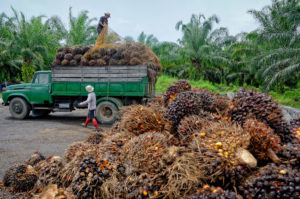India is the world’s largest importer of palm oil, and the second largest consumer after Indonesia. The commodity is widely used as a cooking oil in restaurants (especially at the street- and fast-food end of the industry) and low-income households, as well as in the production of processed foods. Despite its prevalence, however, many people in India are unaware of its presence, let alone the environmental damage the expansion of oil palm plantations in countries such as Indonesia and Malaysia has caused. This lack of awareness means there’s very little market pressure to purchase palm oil from sustainable sources. Indeed, only 2% of India’s palm oil is sustainably produced, according to an internal estimate by the Sustainable Palm Oil Coalition of India. What can be done to change this? Do consumers really have an important role to play, or should the onus be on government and industry? And what has India’s increasing problem with health issues such as diabetes and obesity got to do with it?
Main interviewees
Rohini Vinay, housewife, Chennai
Punyasloka Panda, campaigner, Youth for Sustainability India Alliance
RK Srividya, journalist, Chennai
Swaibu, Safco Oil Dealers, Chennai
Bhavani Shankar, professor, University of Sheffield
Dr Satish Kumar, cardiologist, Kauvery Hospital, Chennai
Anju Venkat, nutritionist, Health Awareness Centre, Mumbai
Bhavya Sharma, representative, Sustainable Palm Oil Coalition of India (I-SPOC)
Credits
Producer and host: Gayathri Vaidyanathan
Commissioning editor: Lizi Hesling
Sound design: Alyssa Moxley
Research: Gayathri Vaidyanathan, RK Srividya
Art work: Nahal Sheikh
Voice-over recording: Baba Prasad at DigiSound Studios
Thanks to: Josie Phillips, Jessica Aldred
Music credits
“Uncertain Ground” by Blue Dot Sessions
Source: https://app.sessions.blue/browse/track/120215
Licence: https://creativecommons.org/licenses/by-nc/4.0/
“The Telling” by Blue Dot Sessions
Source: https://app.sessions.blue/browse/track/124670 Licence: https://creativecommons.org/licenses/by-nc/4.0/
“Hermes Gray” by Blue Dot Sessions
Source: https://app.sessions.blue/browse/track/114852
Licence: https://creativecommons.org/licenses/by-nc/4.0/
“Evidence Room” by Blue Dot Sessions
Source: https://app.sessions.blue/browse/track/124259
Licence: https://creativecommons.org/licenses/by-nc/4.0/
“Di Breun” by Blue Dot Sessions
Source: https://app.sessions.blue/browse/track/120522
Licence: https://creativecommons.org/licenses/by-nc/4.0/
Transcript (excerpts):
Gayathri Vaidyanathan: Palm oil. The cheap vegetable oil with a damning reputation of driving deforestation; of destroying the habitats of orangutans, pygmy elephants and Sumatran rhinos; of worsening climate change and exploiting workers. A reputation that is in many cases only too true.
Palm oil is everywhere in India, which is the world’s second largest consumer after Indonesia. And yet, most people here aren’t aware of its presence, let alone that 98% [the figure is from Bhavya Sharma based on an internal estimate by the Sustainable Palm Oil Coalition of India] of the palm oil used here comes from ethically and environmentally questionable sources.
…
This general lack of awareness of palm oil is something Punyasloka Panda also discovered when he helped conduct a survey of over 1,800 Indians in 2021. He’s a 24-year-old campaigner for the non-profit Youth for Sustainability.
Punyasloka Panda: A lot of people did not know that it is an essential component of each and every element or commodity that we use every day.
Gaya: And why is that, do you think?
Punya: I think a lot of reasons. Number one is that India is not a big producer of palm oil. Hence, there is no advertisement…
Gaya: That’s true. Palm oil isn’t something that’s mentioned in the wider media here in India. There are no ads on TV like there are for wheat, rice or tea.
Punya: Secondly, palm oil is in different forms. So even if you pick up a packet and let’s say it uses palm oil, you look back at the ingredients, you might not be able to spot it.
Gaya: In other words, palm oil – or fractions and derivatives of it – are hiding in plain sight using all sorts of different names.
…
But why is it that palm oil is so common? Well, for one thing, it’s just really versatile. Ice cream made with the oil tastes creamier and is slower to melt; palm oil in margarine extends its shelf life; and derivatives like sodium lauryl sulphate help make things like toothpaste nice and foamy. It also helps that it’s incredibly cheap – the oil palm produces [a lot] more oil per hectare compared to other major oil crops.
The problem is, the high demand for palm oil wrecks the environment. About 85% of the world’s supply comes from Indonesia and Malaysia, where roughly six million hectares of trees were lost within palm oil concessions in the 15 years to 2016. That’s nearly enough trees to cover all of Sri Lanka. In the same period, half the orangutan population in Borneo was affected by logging, deforestation or industrialised plantations, much of this linked to palm oil. Plantation companies routinely burn carbon-rich peatland, releasing smog that blankets much of Southeast Asia. And an investigation by the Associated Press in 2020 found child labour, slavery and allegations of rape on oil palm plantations. Bottom line, the oil is controversial.
But it can be produced more sustainably, taking care of both human rights and the environment. And there are efforts to do this – however flawed – as we explored in episode two of this podcast series. Here’s Punyasloka Panda again.
Punya: If it is grown sustainably without [the] cutting down of trees, without the usage of fire, without the problem being caused to biodiversity, then I think we are good.
Gaya: But sustainable operations are rare. One of the main bodies promoting sustainable production is the Roundtable on Sustainable Palm Oil, better known as the RSPO. They certify producers according to an ambitious set of standards. Certification means you can put a little palm tree label on products. Though I’ve never seen it in India. That’s because only 19% of the world’s palm oil is currently certified, and only a tiny fraction comes to India. In fact, it’s as little as 2% of our total supply, according to [an internal estimate by] the Sustainable Palm Oil Coalition of India. The reason for that is cost.
I want to find out the price of different types of oils, so I’m visiting oil merchant Swaibu of Safco Oil Dealers in Chennai. He’s been in the oil business for 40 years.
Swaibu tells me that one litre of palm oil costs about 165 rupees, or US$2 wholesale.
…
Refined palm is the cheapest of all oils on Swaibu’s shelves. Refined sunflower oil is 25 rupees more expensive. And India’s traditional oils like sesame, mustard and coconut cost two times as much.
…
Bhavani Shankar: It’s very difficult to combat that level of cheapness.
Gaya: That’s Bhavani Shankar, a food systems researcher at the University of Sheffield in the UK.
Bhavani: If it was a marginal thing, if it was a few cents here or there, a few rupees here or there in terms of its cost advantage, then it’s easier to combat. But when it’s several times a cost advantage, then it becomes difficult to combat. Cheap food to a poor person is not a bad thing.
…
Gaya: On the streets of Chennai, when I told people that palm oil causes environmental destruction in Southeast Asia, many people just shrugged. “Yeah, it’s bad,” they said, but they weren’t willing to pay more for their groceries.
…
Perhaps the push away from palm oil needs to come from somewhere else: a concern for our health.
Heart disease is the top killer in India, according to the Global Burden of Disease study. Cardiovascular disease hits Indians at a younger age than Europeans. And certain things can increase a person’s risk of heart disease, such as diabetes – one in 12 Indians have it – hypertension – a staggering 207 million of us have hypertension – and obesity, which has doubled over 17 years. And a top risk factor for all these chronic illnesses is diet. Indians are eating more refined and ultra-processed foods than ever before. Palm oil and its derivatives are key ingredients in many of these foods, contributing to our increasingly poor diets.
…
Gaya: Indians are consuming more edible oils than ever before, especially refined palm oil, which has 50% saturated fat, higher than most other vegetable oils. As far back as 2003, the World Health Organisation said that there is “convincing evidence” that consuming palmitic acid – a type of saturated fat that is found in high concentrations in palm oil – can increase the risk of cardiovascular disease. Here’s scientist Bhavani Shankar again, who has researched the health impacts of palm oil.
Bhavani: There is a camp, to be fair, which feels that saturated fat is not necessarily an issue, and more specifically that palm oil is not necessarily an issue. But it’s also fair to say that probably the majority of health scientists would feel that there are positive benefits to be had from moving away from a highly saturated fat like palm oil towards something that has a better fatty acid content in it. So that is the mainstream opinion that is pretty much widely held around the world.
Gaya: So that is the scientist’s advice, but it’s hard to take when many people don’t even realise the palm oil is there. Anju Venkat, a nutritionist at the Health Awareness Centre in Mumbai, reminds me that refined palm oil is tasteless and odourless. That’s unlike India’s traditional, cold-pressed oils such as mustard or sesame. These are not refined, and retain the smell and taste of the original crop. They also contain things like antioxidants and omega-3, which have many health benefits.
…
Anju Venkat: Smell is the first signal that tells the body whether to eat it or not. Unrefined oils, even when used to fry foods, and even though the digestive load is higher, because of the smell and taste the signal is there for the body to say: “stop eating”. But with refined palm oil, the signal to stop eating doesn’t happen as soon as it can with unrefined. And that is why the amount we eat becomes higher.
Gaya: That’s one of the reasons why it’s so easy to overeat junk foods. As Indians are earning more and moving to cities, we are buying more sweet and salty snacks as well as edible oils. This all adds up to a brewing health crisis that’s arguably just as critical – and hits closer to home for us – as the environmental destruction in Southeast Asia.
…
Gaya: For this story, I’ve been asking people on the street about this, about the environmental destruction. And then they ask me where it’s happening. And I say it’s in Malaysia and Indonesia, and…
Anju: It doesn’t matter to them.
Gaya: It doesn’t matter.
Anju: Yeah.
Gaya: And everyone thinks they don’t eat palm oil, and they think it’s sort of a lower-class thing to do in India, but every single person is eating it all the time.
Anju: See, that’s because it’s again choice, no? I’m choosing not to see something, and I’m choosing not to see something because I think it’s not creating an impact on me.
Whether we like it or not, it really is the fact that the Earth and body is one. So we can’t separate ourselves from what is happening on the Earth. And the information and the understanding about the repercussions of palm oil on the Earth, that is something that as humans, we’ve been given the capacity to care, and we need to be aware of this.
This podcast is part of our ongoing editorial series on palm oil. Explore all the articles here.










